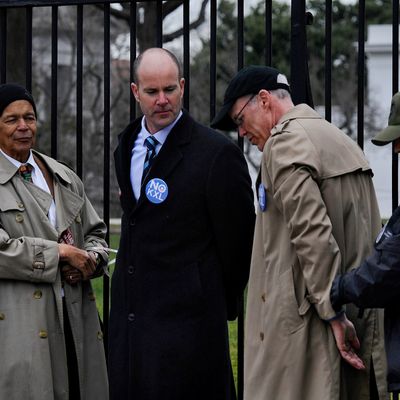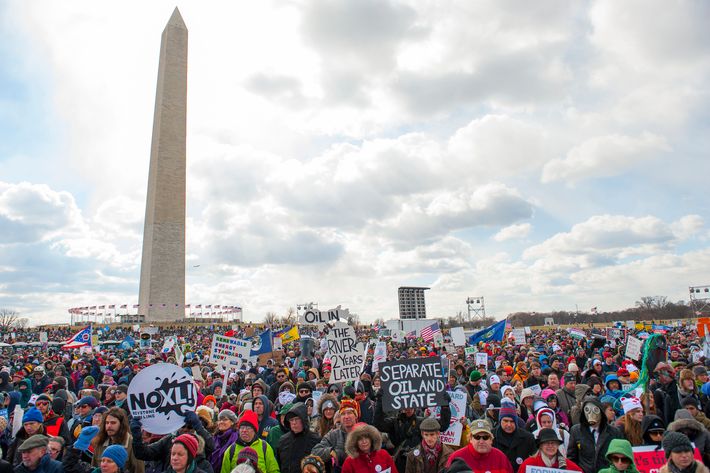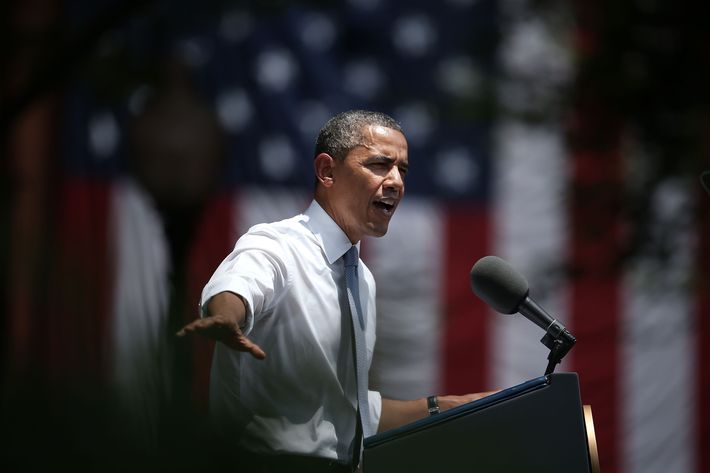
Indispensable New York Times climate reporter Coral Davenport has a story in today’s edition explaining that the Keystone pipeline, which has dominated the climate-change narrative, is substantively trivial, while existing and prospective regulations by the Environmental Protection Agency are massive. The Keystone pipeline would add 18.7 million metric tons of carbon to the atmosphere annually, while forthcoming regulations on existing power plants would remove 200 to 500 million metric tons per year. (Even already-issued regulations on cars and buildings have reduced carbon emissions by many times Keystone’s total.)
I’ve argued that the EPA regulations on existing power plants due to come out this summer are Obama’s chance to fulfill his original climate goals that seemed to slip away when the cap-and-trade bill died in Congress during his first term. That doesn’t mean Obama is destined to succeed. Several things have to go right. First, the regulations have to be good — 200 to 500 metric tons per year is obviously a huge range. Then they have to survive a legal challenge from conservatives.
If that happens, the U.S. should be in compliance with its emissions-reduction targets negotiated with world leaders in Copenhagen in 2009. But then the U.S. has to negotiate a new international treaty at the end of 2015. American compliance isn’t sufficient to forge such a treaty, but it is almost certainly necessary — developing countries aren’t going to abandon the cheap, dirty energy-development path the United States and Europe followed if the United States isn’t making some sacrifices. Conservatives argue that countries like China will never give up their dirty energy resources, so even trying for a treaty is pointless, but in reality, China is actually shutting down lots of coal plants and curbing its coal usage already.
And then, in the years to come, successor presidents will have to implement even deeper cuts to greenhouse gas emissions, which hopefully will be easier to implement once green energy sources have gained a stronger foothold.

It’s a lot of stuff. You’ll notice, though, that the Keystone pipeline doesn’t really factor in to any of these steps. Davenport quotes a parade of experts who confirm that EPA regulations are the climate story, and Keystone is a sideshow:
“the Keystone pipeline is a rounding error,” said Kevin Book, the founder of ClearView Energy Partners, an energy analysis firm …
“Rather than focus on a single piece of infrastructure whose climate change impact is quite limited, as the State Department found, we should focus on the steps the administration can take that would significantly reduce emissions, and by far the biggest is the use of the Clean Air Act to regulate power plant emissions,” Jason Bordoff, a former Obama administration official, wrote by email. Until 2013 he was senior director for energy and climate change on the National Security Council staff; he now directs Columbia University’s Center on Global Energy Policy.
Michael Levi, director of the energy security and climate change program at the Council on Foreign Relations, said that “with regulations on power plants and cars and trucks, you’re making a change that is likely to stick; with Keystone, you’re not.” …
“The regulations on vehicles and power plants — that’s going be the centerpiece of what the U.S. can take to the next round of diplomatic talks,” said Adele Morris, an energy and climate change policy expert at the Brookings Institution. David Goldwyn, an analyst who ran the Bureau of Energy Resources under former Secretary of State Hillary Rodham Clinton, commented: “By comparison, the decision on Keystone is irrelevant or insignificant. It’s a drop in the bucket.”
If Obama approves Keystone, as long as the U.S. is scheduled to meet its emission targets, he can still negotiate an international treaty. If he nixes Keystone, if he does not have the U.S. on track to meet its targets, he probably can’t negotiate a treaty. Telling China, Hey, we’re going to bust through our caps, but at least we made Canada ship its oil by rail isn’t going to help.

Why have environmentalists elevated the issue to a crusade?
Several months ago, I made the case that Keystone amounted to a gigantic misallocation of attention by environmentalists. After numerous environmentalists pushed back (see representative takes by Charles Pierce and Joe Romm), I believe this even more strongly. The best case I’ve seen for the anti-Keystone campaign, by Ryan Cooper, is that the anti-Keystone movement shifts the Overton window. “I would not be surprised if President Obama enables the pipeline, while eventually getting tougher rules through the EPA,” writes Cooper. “We’d have [anti-Keystone activist Bill] McKibben to thank for that.”
I suppose it could work — build a mass movement by persuading hundreds of thousands of idealists that a marginal efficiency improvement in one energy project amounts to a life-or-death moment for the future of the Earth, and then leverage the wildly out-of-scale attention to that issue to move through a regulation that actually does matter a huge amount. The possibility for backfire seems non-trivial. If it does play out this way, presumably anti-Keystone activists will not turn on the leaders who threw them into a cause of dubious relevance but instead direct their anger at the administration that sold out their movement. And then imagine Obama does approve the pipeline that McKibben has called “game over” for the fight to mitigate climate change. How do you mobilize activists after the game is over?






























